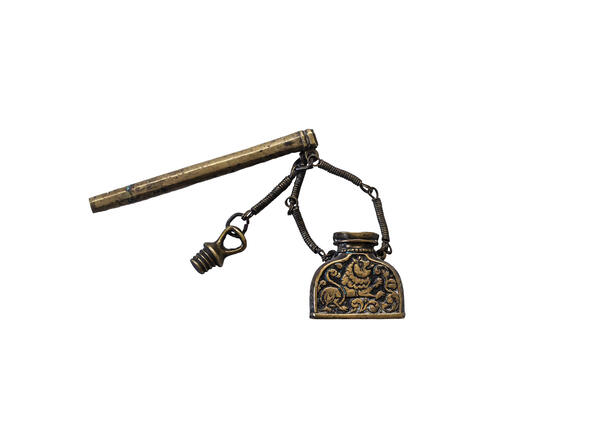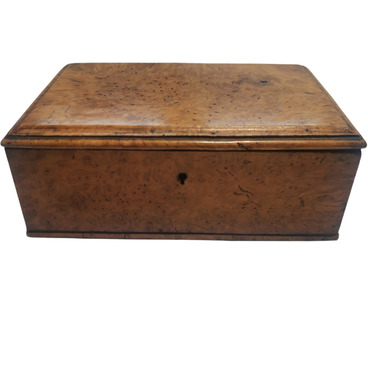Up until the end of the 17th century, inkwells were quite a rare and expensive item. Not many literate people could afford them, only the ones for whom writing was a job. For example, civil servants who wrote down decrees, or monks who rewrote books and chronicles. Besides them, inkwells were used by members of the royal family, the boyars, and the nobility.
Almost all inkwells in the 16th-18th centuries were portable. People would carry one inkwell with them, and would never buy many of them. For convenience, a chain was latched onto it, by which the inkwell could be attached to a belt. Therefore, it was also a conventional part of the attire of clerks, treasurers, tax collectors.
Inkwells in the form of a bottle with a narrow neck, which could be closed with a cork, were considered especially useful. Due to this shape the ink did not spill. During writing, the vial could be placed on any surface or simply held in the hand.
The ink was usually made out of the so-called oak galls (a seed from an oak tree), cherry gum, and other materials. Back in the day, a freshly written page was sprinkled with dry river sand or pounce so that the ink would not smudge. To store the sand, special containers were made — sandboxes or pounce boxes. The sand was later replaced by blotting paper. To get rid of ink excesses, people also used the press-buvard, a rounded wooden block, with cloth, felt, or another absorbent material glued onto it.
In the second half of the 18th century, the portable inkwell became a necessary item for merchants, who had to travel frequently. They also always had with them quill holders — tube-shaped cases for storing goose quills, a very popular accessory in the 17th and 18th centuries. It was used to keep the tip of the quill pen from being damaged. Sometimes an inkwell and a quill holder could be connected by a chain and sold as one stationery set.
Only three or four feathers from a goose were suitable for writing. To prepare the quill for writing, it had to be sharpened. To hold the quill pen more comfortably, masters stripped some barbs from it before sharpening. It was then boiled in alkaline, fired, and tempered in hot sand. During the sharpening stage, masters took into account the peculiarities of the hand of the future owner. Quill pens dulled rather quickly, but they could be re-sharpened. Damaged quill pens left blotches and smudges, splattered the paper with ink. The paper was rough and uneven, which also made it difficult to write.
Almost all inkwells in the 16th-18th centuries were portable. People would carry one inkwell with them, and would never buy many of them. For convenience, a chain was latched onto it, by which the inkwell could be attached to a belt. Therefore, it was also a conventional part of the attire of clerks, treasurers, tax collectors.
Inkwells in the form of a bottle with a narrow neck, which could be closed with a cork, were considered especially useful. Due to this shape the ink did not spill. During writing, the vial could be placed on any surface or simply held in the hand.
The ink was usually made out of the so-called oak galls (a seed from an oak tree), cherry gum, and other materials. Back in the day, a freshly written page was sprinkled with dry river sand or pounce so that the ink would not smudge. To store the sand, special containers were made — sandboxes or pounce boxes. The sand was later replaced by blotting paper. To get rid of ink excesses, people also used the press-buvard, a rounded wooden block, with cloth, felt, or another absorbent material glued onto it.
In the second half of the 18th century, the portable inkwell became a necessary item for merchants, who had to travel frequently. They also always had with them quill holders — tube-shaped cases for storing goose quills, a very popular accessory in the 17th and 18th centuries. It was used to keep the tip of the quill pen from being damaged. Sometimes an inkwell and a quill holder could be connected by a chain and sold as one stationery set.
Only three or four feathers from a goose were suitable for writing. To prepare the quill for writing, it had to be sharpened. To hold the quill pen more comfortably, masters stripped some barbs from it before sharpening. It was then boiled in alkaline, fired, and tempered in hot sand. During the sharpening stage, masters took into account the peculiarities of the hand of the future owner. Quill pens dulled rather quickly, but they could be re-sharpened. Damaged quill pens left blotches and smudges, splattered the paper with ink. The paper was rough and uneven, which also made it difficult to write.



